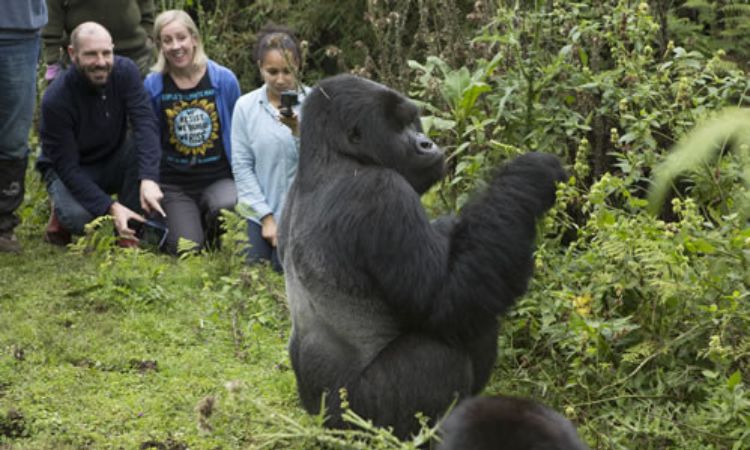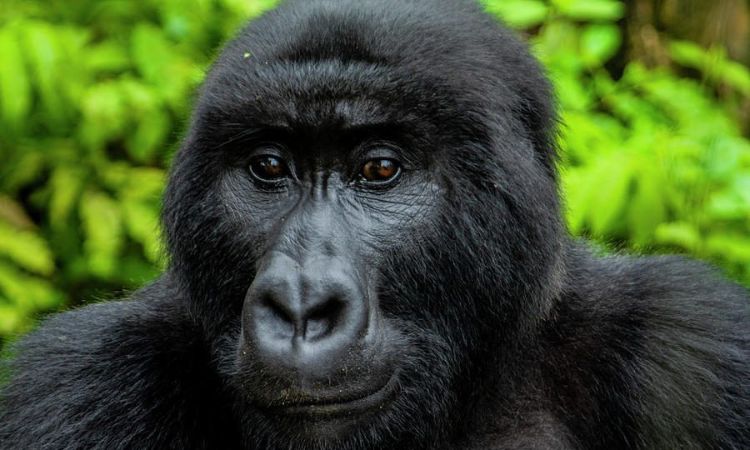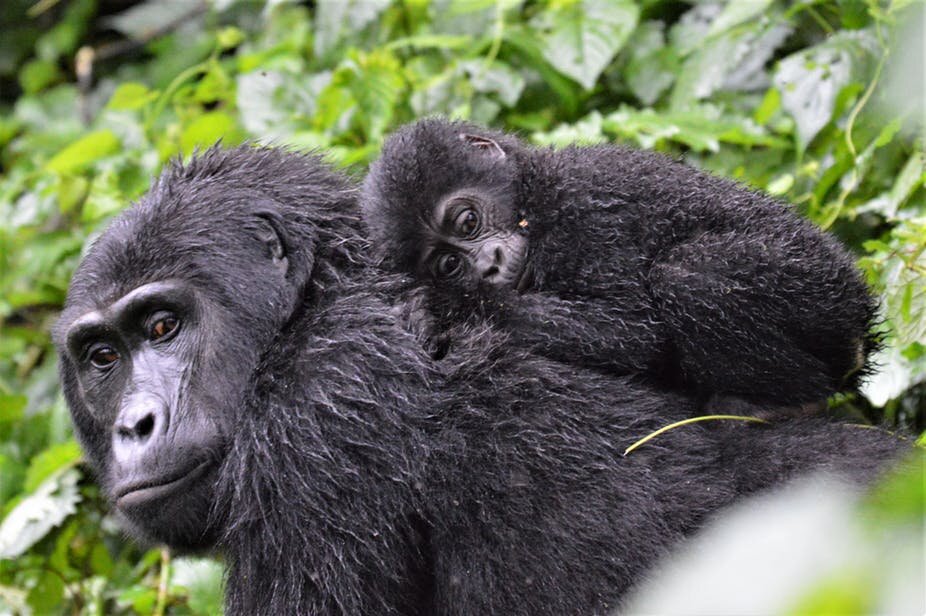Gorilla Revealed: 10 Fascinating Facts about Gorillas.
A Gorilla are very captivating creature with countless unique features that make them stand out. Gorillas are found in different countries in Africa, including Democratic Republic of Congo, Rwanda, Uganda, Equatorial Guinea, Central African Republic and Cameroon.
Gorillas are divided into 2 subspecies; eastern gorilla and the western gorilla.
This article will focus on the Eastern Gorillas due to conservation efforts by these 3 countries; Uganda, Rwanda and Congo that made sure that the specie once on verge of extinction is preserved.
They are gentle apes remaining in the Virungas, in the northwest of Rwanda part of volcanoes as well as Mgahinga in the southwest part of Uganda and also the Virungas of the central part. Gorillas can also be found in Bwindi impenetrable national park located in the southwest part of Uganda.
Because Uganda is one of the only countries where you can find gorillas species, many tourists love to visit the pearl of Africa to view these amazing mammals and join in the trekking safaris.
Therefore, if you’re planning for a Uganda gorilla safari, you need to know some facts about awesome primates and below are listed;
Facts about Gorilla:
Gorilla Description:
Mountain gorillas stand out with their long, thick fur, a distinctive feature setting them apart from other gorilla species. Additionally, they boast unique nose prints, while male mountain gorillas tip the scales at double the weight of their female counterparts.

With deep, dark brown eyes encircled by a black ring, these magnificent creatures typically weigh around 220kg (490lb) and reach heights of 1.9m (6ft). Adult males, known as silverbacks, earn their moniker from the gray or silver hair that adorns their backs.
The tallest confirmed silverback measured a towering 1.94m. While predominantly terrestrial, gorillas will scale tree branches if sturdy enough to support their weight.
Distinct Subspecies of Gorilla
Mountain gorillas are one of two subspecies of the eastern gorilla, distinct from the eastern lowland gorilla (Gorilla beringei graueri). They diverged genetically about 1.7 million years ago, adapting to high-altitude forests (2,200–4,300 meters).
Their thicker, darker fur protects against cold, unlike their lowland cousins in flatter, warmer forests. Genetic studies in 2023 confirmed low inbreeding risks in Bwindi, ensuring healthier populations than previously feared.
Impressive Physical Traits
Adult male mountain gorillas weigh 180–200 kg and stand up to 1.7 meters, while females are smaller at 90–100 kg and 1.5 meters. Their dark fur, denser than other gorillas, insulates against 0–10°C temperatures in the Virungas.
Silverbacks develop a sagittal crest on their skulls, anchoring powerful jaw muscles. Their arm span (2.3 meters) aids knuckle-walking, and their strength—lifting up to 800 kg—makes them 10 times stronger than a human.
Unique Nose Prints
Each mountain gorilla has a unique nose print, akin to a human fingerprint, used by researchers to identify individuals. These patterns, formed by wrinkles above the nostrils, remain consistent lifelong.
In Bwindi, conservationists use nose prints alongside behavioral traits to monitor health and group dynamics. This non-invasive method, refined by 2025, helps track population growth without disturbing the gorillas.
Complex Communication
Mountain gorillas communicate through a mix of vocalizations, gestures, and facial expressions. They use 25 distinct sounds, including grunts for group cohesion, roars during silverback disputes, and soft “belch vocalizations” to express contentment.
Body language—like chest-beating (more display than aggression)—signals dominance or excitement. Eye contact is rare, as it’s perceived as threatening. Studies in 2024 revealed females use subtle hums to initiate mating, showcasing nuanced social cues.
Slow Reproduction Rates
Female mountain gorillas reach sexual maturity at 8–10 years, males at 12–15. Females give birth every 4–6 years after an 8.5-month gestation, producing one infant (2–3 kg). Infant mortality is high (up to 30% in the first year), often due to disease or infanticide by rival silverbacks.
Only 50% of females reproduce successfully, making population growth slow. Conservation efforts prioritize protecting breeding females to sustain numbers.
Lifespan and Aging
Mountain gorillas live 35–50 years in the wild, with females outliving males on average. Silverbacks face higher mortality from defending groups against predators (leopards, rarely) or rival males. Aging gorillas develop arthritis, dental wear, and graying fur.
In 2025, veterinary teams in Rwanda use drone-delivered supplements to treat older individuals, extending lifespans in habituated groups. Captive gorillas, like those in zoos, may reach 60 but lack wild vigor.
Human-Like Behaviors
Mountain gorillas share 98.7% of their DNA with humans, reflected in their behaviors. They mourn deceased group members, with females cradling dead infants for days. Juveniles play tag-like games, tumbling down slopes, while adults groom to strengthen bonds.
Silverbacks display empathy, comforting distressed members. A 2023 study noted a Bwindi gorilla using leaves as a makeshift “umbrella” during rain, hinting at tool use.
Gorilla Life Cycle:
An interesting statistic, gorillas and humans share a staggering 98% genetic similarity. Females typically reach sexual maturity around 7-8 years of age, while males tend to mature later.
Female gorillas typically enter their breeding phase around the age of 10, with births occurring after a gestation period of approximately 8-9 months. This cycle repeats every 4-5 years. Consequently, these majestic creatures can live up to 54 years of age.
Gorilla Habitat and Diet:
In Uganda, two primary locations host these majestic creatures: Bwindi Impenetrable National Park and Mgahinga Gorilla National Park. Among them, Bwindi Impenetrable National Park boasts the largest gorilla population, with over 400 individuals thriving within its depths.
Shrouded by a dense canopy that filters sunlight, Bwindi earns its moniker as the “place of darkness.” Here, the gentle giants predominantly feast on a variety of vegetation, comprising leaves, shoots, and stems (85.8% from 142 plant species).
Additionally, their diet includes flowers (2.3%), roots (3.3%), fruits (1.7%), bark (6.9%), and occasionally, small invertebrates (0.1%).
Adult male eastern gorillas can consume up to 34kg (75lb) of vegetation daily, while their female counterparts typically consume up to 34kg (40lb).
Gorilla Social Structure:
In the Virunga Gorillas, the typical tenure of a dominant silverback spans approximately 4.7 years. About 61% of groups consist of a single adult male alongside several females, while 36% comprise multiple adult males.
These magnificent creatures form cohesive groups of up to 30 members, consisting of females and their offspring. The esteemed leaders and elder gorillas, known as silverbacks, assume the responsibility of overseeing all family activities and ensuring the well-being of the young ones.

Silverbacks also dictate the group’s movements and stand as vigilant protectors, shielding the family from threats posed by humans, predators like leopards, and other primates. During resting periods, they command attention as the focal point of the group.
Upon the demise of a dominant silverback, the family structure may undergo upheaval unless another male silverback assumes leadership. In some cases, this transition may prompt family members to splinter and join other unrelated groups.
Behavior:
Given their formidable strength, many wonder if gorillas are inherently dangerous. However, the truth is that these majestic creatures are typically gentle and reserved in nature.
Remarkably, gorillas share similar emotions with humans. They express distress through cries when injured and exhibit joy through laughter during moments of happiness. Witnessing such emotional depth is truly a marvel!
Aggression:
Under normal circumstances, these gentle giants maintain peace and tranquility. However, if provoked or disturbed, they can become unpredictable and may resort to aggression, particularly when tourists encroach upon their serene environment.
Visitors are strongly advised to maintain a respectful distance from gorillas and refrain from any actions that could be perceived as threatening, such as mimicking their behaviors or using flash photography. Such gestures can disrupt their natural behavior and provoke unwanted reactions.
Vocalization:
Gorillas employ a variety of sounds to communicate with one another. Among their repertoire are 25 distinct vocalizations, each serving a specific purpose, whether during social interactions or self-discipline.
The resounding roars and piercing screams, often emanating from silverbacks, serve as signals and warnings. Conversely, during periods of relaxation and feeding, the air fills with deep, rumbling hiccups, signifying contentment, a sound that resonates repeatedly throughout the group.
Fears:
It seems that Eastern Gorillas harbor a natural aversion to certain insects and reptiles. Despite their innate curiosity, even infants, known for their inclination to investigate anything that moves, will actively avoid encounters with chameleons and other reptiles.
Moreover, they exhibit apprehension toward bodies of water, unless they can traverse streams without getting wet.
Gorillas Like Routine:
Certain gorillas adhere to a distinctive daily regimen, often rising promptly at 6:00 am to commence their search for ample quantities of vegetation to consume.
However, in colder weather conditions, they may take a brief respite before resuming their quest for sustenance until nightfall at 6:00 pm.
These colossal primates typically indulge in a midday slumber. Remarkably, they seldom drink water, as they derive much of their hydration from the plants they consume.
Use Tools:
Gorillas display remarkable intelligence and uniqueness among mammals. Habituated individuals, for instance, are adept at learning sign languages and communicating with humans, quickly adapting to make their lives more convenient. They ingeniously utilize sticks and branches to extract insects from the ground or hollow trees.
Moreover, these primates exhibit extraordinary caregiving behaviors. They construct beds for themselves and their offspring using leaves, twigs, and vines, a practice that showcases their remarkable nurturing instincts.
In addition to their resourcefulness, gorillas demonstrate a sense of community and protection. They employ branches to rescue young members entangled in vines and assist them in traversing streams and creeks by fashioning makeshift bridges from logs.
This compassionate behavior, often led by the silverback, extends to removing snares from the young ones, highlighting their exceptional empathy and care within their social groups.

Critically Endangered but Recovering
Mountain gorillas are classified as critically endangered by the IUCN, with only about 1,063 individuals left as of the 2020 Bwindi-Sarambwe census.
Once on the brink of extinction (down to 254 in the 1980s), their numbers have risen due to rigorous conservation in Uganda’s Bwindi Impenetrable National Park and the Virunga Massif (spanning Rwanda, Uganda, and DRC).
Anti-poaching patrols, veterinary interventions, and ecotourism have boosted populations by 3% annually, though habitat loss and disease remain threats.
Vulnerability (Human Diseases):
With a genetic similarity of 98% to humans, gorillas are susceptible to contracting human diseases such as flu and cough, along with various other communicable illnesses, within a short span of exposure to tourists.
To mitigate this risk, tourists are urged to limit group sizes to a maximum of 8 members when visiting gorilla families and are advised to spend no more than 1 hour per day in the company of these gentle giants.
In light of these considerations, travelers embarking on gorilla safaris in Uganda, Rwanda, and the Democratic Republic of Congo must remain vigilant and familiarize themselves with mountain gorilla characteristics for an unforgettable Gorilla Trekking safari experience.




The last image of the gorilla looks thrilling, aren’t these creatures dangerous?!